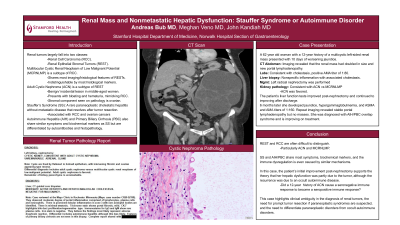Back

Poster Session E - Tuesday Afternoon
Category: Liver
E0544 - Renal Mass and Nonmetastatic Hepatic Dysfunction: Paraneoplastic or Autoimmune?
Tuesday, October 25, 2022
3:00 PM – 5:00 PM ET
Location: Crown Ballroom

- AB
Andreas W. Bub, MD
Stamford Hospital
Stamford, Connecticut
Presenting Author(s)
Andreas W. Bub, MD1, Jonathan Kandiah, MD2, Meghan Veno, MD1
1Stamford Hospital, Stamford, CT; 2Norwalk Hospital, Norwalk, CT
Introduction: Renal tumors fall into two classes of varied malignant potential, renal cell carcinoma (RCC) and renal epithelial stromal tumors (REST). Multilocular cystic renal neoplasm of low malignant potential (MCRNLMP), a type of RCC, shares many traits of RESTs. Adult Cystic Nephroma (ACN), a benign and incidentally found REST in adult women presents with bloating and hematuria, like RCC. RCC is typically malignant and linked to paraneoplastic disorders, such as Stauffer’s Syndrome (SS). SS, a rare paraneoplastic disorder, causes cholestatic hepatitis without metastatic disease, resolving after tumor resection. Autoimmune Hepatitis (AIH) and Primary Biliary Cirrhosis (PBC) also share most characteristics but are differentiated by autoantibodies and pathology. We present a 62 year old woman with a renal mass and jaundice that improved post-nephrectomy but was later diagnosed with AIH/PBC.
Case Description/Methods: A 62 year old Woman with a 12-year history of a multicystic left renal mass presented with 10 days of jaundice. Urinalysis showed hyperpigmentation, serum studies were consistent with cholestasis and showed an autoantibody titer of 1:80. A CT scan showed the mass doubled in size as well as new portal lymphadenopathy. Liver biopsy showed nonspecific inflammation and cholestasis but no malignancy. Radical nephrectomy was performed with pathology showing ACN or MCRNLMP. The patient’s liver function tests improved post-nephrectomy and were improving after 2 weeks. 6 months later she developed jaundice, hypergammaglobulinemia, and elevating autoantibodies titers of 1:160. Repeat imaging revealed no changes and she was diagnosed with AIH/PBC overlap.
Discussion: REST and RCC can be hard to distinguish, like ACN from MCRNLMP. They share a cellular origin plus histopathological and imaging findings. Moreover SS and AIH/PBC share most traits and even cause immune dysregulation in similar manners. The initial improvement post resection hints that her hepatic dysfunction was partly due to the tumor, though she suffered relapse due to an occult autoimmune disorder. The similarities between the malignancies and immune disorders involved may mean it is possible that the former led to the latter. A long history of indolent nephroma left time for a seronegative immune response to become a seropositive one. This case highlights ambiguity in diagnosing renal tumors, the need for prompt resection if paraneoplastic disorder arises, and the need to differentiate paraneoplastic disorders from autoimmune disorders.
Disclosures:
Andreas W. Bub, MD1, Jonathan Kandiah, MD2, Meghan Veno, MD1. E0544 - Renal Mass and Nonmetastatic Hepatic Dysfunction: Paraneoplastic or Autoimmune?, ACG 2022 Annual Scientific Meeting Abstracts. Charlotte, NC: American College of Gastroenterology.
1Stamford Hospital, Stamford, CT; 2Norwalk Hospital, Norwalk, CT
Introduction: Renal tumors fall into two classes of varied malignant potential, renal cell carcinoma (RCC) and renal epithelial stromal tumors (REST). Multilocular cystic renal neoplasm of low malignant potential (MCRNLMP), a type of RCC, shares many traits of RESTs. Adult Cystic Nephroma (ACN), a benign and incidentally found REST in adult women presents with bloating and hematuria, like RCC. RCC is typically malignant and linked to paraneoplastic disorders, such as Stauffer’s Syndrome (SS). SS, a rare paraneoplastic disorder, causes cholestatic hepatitis without metastatic disease, resolving after tumor resection. Autoimmune Hepatitis (AIH) and Primary Biliary Cirrhosis (PBC) also share most characteristics but are differentiated by autoantibodies and pathology. We present a 62 year old woman with a renal mass and jaundice that improved post-nephrectomy but was later diagnosed with AIH/PBC.
Case Description/Methods: A 62 year old Woman with a 12-year history of a multicystic left renal mass presented with 10 days of jaundice. Urinalysis showed hyperpigmentation, serum studies were consistent with cholestasis and showed an autoantibody titer of 1:80. A CT scan showed the mass doubled in size as well as new portal lymphadenopathy. Liver biopsy showed nonspecific inflammation and cholestasis but no malignancy. Radical nephrectomy was performed with pathology showing ACN or MCRNLMP. The patient’s liver function tests improved post-nephrectomy and were improving after 2 weeks. 6 months later she developed jaundice, hypergammaglobulinemia, and elevating autoantibodies titers of 1:160. Repeat imaging revealed no changes and she was diagnosed with AIH/PBC overlap.
Discussion: REST and RCC can be hard to distinguish, like ACN from MCRNLMP. They share a cellular origin plus histopathological and imaging findings. Moreover SS and AIH/PBC share most traits and even cause immune dysregulation in similar manners. The initial improvement post resection hints that her hepatic dysfunction was partly due to the tumor, though she suffered relapse due to an occult autoimmune disorder. The similarities between the malignancies and immune disorders involved may mean it is possible that the former led to the latter. A long history of indolent nephroma left time for a seronegative immune response to become a seropositive one. This case highlights ambiguity in diagnosing renal tumors, the need for prompt resection if paraneoplastic disorder arises, and the need to differentiate paraneoplastic disorders from autoimmune disorders.
Disclosures:
Andreas Bub indicated no relevant financial relationships.
Jonathan Kandiah indicated no relevant financial relationships.
Meghan Veno indicated no relevant financial relationships.
Andreas W. Bub, MD1, Jonathan Kandiah, MD2, Meghan Veno, MD1. E0544 - Renal Mass and Nonmetastatic Hepatic Dysfunction: Paraneoplastic or Autoimmune?, ACG 2022 Annual Scientific Meeting Abstracts. Charlotte, NC: American College of Gastroenterology.
